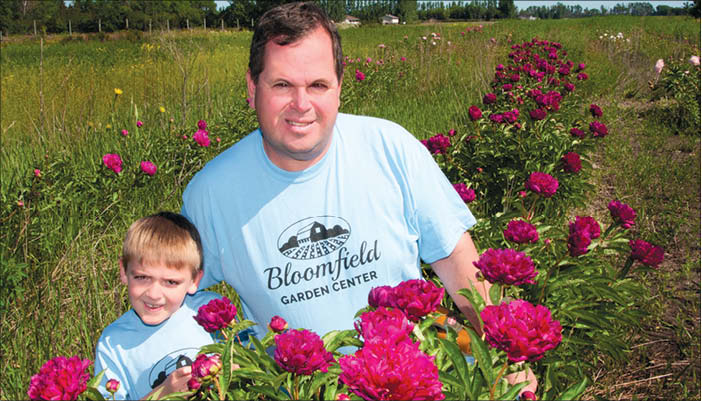An acre of peonies is bursting with blossoms near Sabin, christening a familiar greenhouse with a brand new name– the Bloomfield Garden Center.
“This is a perfect area for peonies,” observes Charlie Pingel, who has spent most of his nearly 50 years in the greenhouses five miles south of Moorhead on 70th Street South. “Our area has just what they need to make them thrive – long, warm summer days and cool nights. We’re situated on the edge of a rich ancient lake bottom.
“The more sun they can get, the better. They’re naturally drought resistant, and they’re hardy,” he continues. “Once they get established, just let ‘em go. They’ll be fine.”
A dozen years ago, Charlie and his wife Shelly took that perfect prescription to heart. They began collecting and cultivating dozens of the handsome, big-bloomed bushes behind the greenhouses that used to be known as Levi Runion’s. The garden center’s new name is a tribute to the perennials they’re passionate about – the literal field of blooms they’re see as just the beginning of a larger, more ambitious project.
“I’ve loved peonies since I was a little girl,” Shelly Pingel reminisces. Her family’s farmstead near Underwood, Minn., was ringed with them. Her mother picked and dried them, letting nature turn them into delicate, blushing floral balls for her dried-flower arrangements.
Even now, farms and city yards come to life in the spring with the familiar garden favorite. Six- to ten-inch blooms capture every shade of dark red to pearl white, centering around pinks and corals. The long-lived plants are part of countless families’ garden legacies, perhaps planted first by Great-Grandma; the same plants, divided and transplanted, now thrive in many fourth-generation gardens.
The Pingels became professional purveyors of peonies a dozen years ago. “Tubers grow great here – sugar beets, potatoes,” Charlie explains. “Peonies are tuberous, too. They’re easy to ship and, after you plant them, they almost always do well.”
Looking out on his field this spring, he predicts, “This is just the beginning. We have around 75 varieties right now. We may increase that to 150 in the near future. We have five tillable acres in this plot. …”
Right now their garden center is selling out of annual flowers and vegetables. As the planting season wanes, they’ll resume their visits to arts and crafts fairs around the area – a prime venue for selling bare tubers ready to plant in the fall.
Casual fair-growers may be baffled by their crates of gnarled tubers buried in handfuls of mulch. Not so, the avid gardeners who understand the hidden beauty ready to emerge from such an unpromising package. A growing proportion of their customers also discover them online; their website, bloomfieldgardencenter.com, is being expanded to accommodate these distant growers.
The Pingels’ inventory currently includes several dozen cultivars grown in commercial quantities. They range from traditional old favorites like Festiva Maxima, with its globular white double blossoms, and huge pure pink Sarah Bernhardt — both straight from Grandma’s garden — to much newer hybrids like Garden Parfait, with cerise pink guard petals and shell pink to white centers highlighted with prominent golden stamens, and flashy pink-and-cream Raspberry Splash. Other varieties sport a range of colors that simply defies precise description, from magenta to shell pink to coral to carmine and cream, and even bright yellow. The only color that defies the breeders is blue.
Shapes, too, run the gamut. Minnesota gardeners are most familiar are the fluffy doubles and semi-doubles. Single and Japanese varieties flaunt a flatter shape with bright yellow pollen-bearing stamens in their hearts. And then there are the bombs, with a halo of large flat petals surrounding a boisterous ball in the center.
Older varieties are often famously fragrant. Some of the newer cultivars – the streaked and multi-colored blooms, for instance – have less of the sweet perfume.
Most gardeners, Charlie says, love peonies. If they have complaints, it’s that the plants tend to flop after a rain or that they attract ants. He notes that breeders have developed peonies with much sturdier stems since World War II; the flattened bushes are probably more antique varieties. As for the ants, that’s why we have peonies. “Ants are absolutely essential for pollination,” he says of the notorious six-legged workers. “They’re part of nature’s plan. No ants …no flowers.”
He says that established plants can be divided every five or six years – more heirlooms to share among the family. Or you can overlook that step. Either way, he says, they’ll be just fine. “They’re very forgiving,” Charlie observes. “Give them a chance, some sun and a little rain, and they’ll be happy for a hundred years.”



